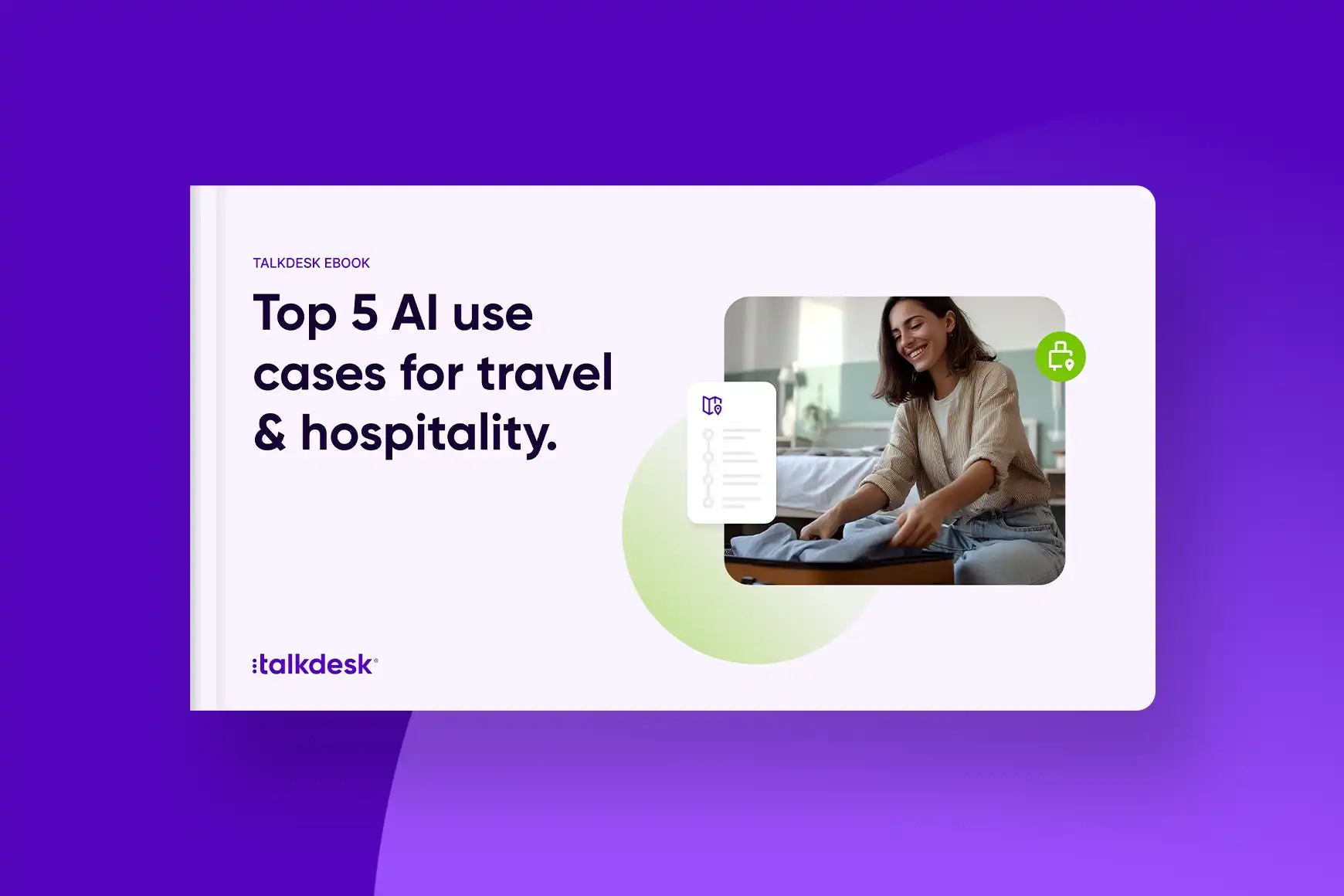Travel customer experience (CX): What it is and why it matters

By Celia Cerdeira
0 min read

Travel customer experience is quickly becoming a key deciding factor in how travelers choose, trust, and remember brands.
Travel experiences make up a market worth more than $1 trillion, with activities like guided tours, concerts, and nature hikes already accounting for $250–310 billion annually and growing at double-digit rates. Younger generations, in particular, are driving this surge: more than half of Gen Z travelers say they would rather pay for experiences over anything else during a trip.
As expectations rise, travelers look forward to seamless, digital-first interactions that feel personal and trustworthy at every step. For airlines, hotels, booking platforms, and tour operators, delivering an exceptional travel customer experience has become the most important differentiator.
In this guide, we’ll explore what travel customer experience means, why it matters, and how leading organizations are raising the bar for service that keeps customers coming back.
What is customer experience in travel?
Travel customer experience is the entire journey a traveler has with a brand, starting the moment they begin dreaming about a trip, all the way through to the support they receive once they’re back home, like assistance with refunds, recovering lost belongings, or earning loyalty rewards. It touches every step: browsing digital booking platforms, checking in at airports, being greeted at hotels, connecting with local guides, getting help when something goes wrong, or sharing feedback that helps improve future trips.

EBOOK
In travel and hospitality, expectations move as fast as your guests. They demand speedy answers, personalized experiences, and seamless service, everywhere, every time. However, CX teams don’t need to trade off automation and empathy. Explore how AI is transforming the customer experience for travel and hospitality organizations.
Why is customer experience important in travel?
In travel, customer loyalty is everything. Unlike industries built on one-off purchases, the travel sector thrives on repeat bookings and personal referrals. The strength of customer experience is what fuels both.
Since travel often involves multiple players, including airlines, hotels, tour operators, and local providers, every interaction matters. One frustrating moment, like a confusing booking process or a delayed flight with poor communication, can overshadow days of enjoyment. On the other hand, a positive customer experience transforms basic logistics into seamless, memorable journeys. It’s the difference between a trip that’s simply taken and one that’s truly treasured.
What’s driving personalization in travel?
Personalization has become the defining factor in modern travel customer experience. Today’s travelers expect every interaction to reflect their preferences, context, and intent—not just their itinerary. Price and convenience still matter, but what truly earns loyalty is recognizing a traveler’s needs before they even ask.
For travel and hospitality providers, the challenge lies in connecting data that’s often trapped in separate booking, loyalty, and service systems. AI and machine learning enable the integration of these insights into a single, intelligent view of the traveler. With this visibility, teams can anticipate needs, tailor recommendations in real time, and proactively communicate across every channel.
The result is a shift from reactive service to predictive engagement where disruptions are managed before they impact the traveler, offers feel personally relevant, and every interaction builds trust.
How to improve customer experience in travel: 5 tips.
Creating an exceptional travel customer experience isn’t just about moving people from point A to point B. Here are five tips that highlight how travel organizations can design moments of trust, ease, and delight across the customer journey.
1. Use AI agents to personalize interactions.
AI agents are transforming how travel providers deliver personalized service at scale. By analyzing data from bookings, loyalty programs, and past interactions, AI agents create a complete, real-time view of each traveler, capturing their preferences, intent, and journey history.
With this context, AI agents can tailor interactions instantly: recommending upgrades, offering proactive solutions during disruptions, or routing travelers to the best available resource. They can also support human agents behind the scenes, surfacing key details, suggesting next best actions, and ensuring every response feels relevant and consistent across channels.
2. Automate digital customer experience wherever possible.
Travelers expect speed, clarity, and consistency from every digital interaction. Customer experience automation makes this possible at scale. With AI-powered platforms, travel organizations can eliminate friction points such as long wait times or repetitive questions by offering self-service tools like automated check-in, booking changes, and instant responses to FAQs.
These options reduce reliance on live agents while giving travelers more control over their journey. With automation, travel organizations gain efficiency and higher customer satisfaction, while travelers enjoy fast, accurate, and personalized support.
3. Understand what guests are looking for.
Travelers expect a seamless journey across every channel they use, from booking apps and live chat to phone support and on-site interactions. An omnichannel customer journey ensures that context follows the traveler, so they don’t need to repeat information or switch channels in frustration.
For instance, a traveler who starts by browsing flights on a mobile app may later confirm their booking through a website, receive real-time updates via text, and reach out to a live agent at the airport if plans change. With an omnichannel customer experience, every interaction is connected, so the agent already knows the traveler’s itinerary, previous interactions, and current issues. This reduces frustration, speeds resolution, and creates a sense of being recognized and valued.
4. Use AI-powered analytics to improve guest engagement.
To elevate the travel customer experience, providers need visibility into what’s working and what’s not. Tracking business intelligence KPIs gives CX teams a clear view of traveler interactions, service performance, and overall satisfaction. By consolidating data from contact centers, booking systems, and on-site operations, travel organizations can pinpoint where friction occurs and where engagement excels.
AI-powered analytics make this intelligence actionable. For instance, real-time dashboards can flag rising call volumes at airline support centers before they impact wait times, or identify patterns like repeated questions about flight changes or loyalty benefits. Speech and text analytics can surface traveler sentiment across voice, chat, and email, revealing common frustrations or opportunities for proactive communication.
5. Build traveler trust with secure, responsible AI.
In travel, trust is everything, and it starts with protecting customer data. As organizations adopt AI to personalize and automate experiences, maintaining strong security and governance standards is essential. Travelers share sensitive information at every stage, from payment details to travel itineraries, and expect companies to handle it safely and transparently.
Modern CX solutions use AI with built-in guardrails to ensure data integrity and compliance across all touchpoints. Encryption, role-based access, and automated redaction keep customer details secure, while AI models are designed to follow strict privacy and ethical use guidelines. This safeguards traveler information while maintaining the accuracy and reliability of AI-driven recommendations and support.
What does a poor customer experience in travel look like?
Even the most carefully planned trip can be undermined by disconnected systems and inconsistent service that leave travelers feeling frustrated and forgotten. Some of the most common drivers of poor travel customer experience include:
-
Unhelpful interactions. When agents lack the right tools or access to traveler data, they can’t provide quick, informed support. Simple issues—like rebooking after a delay or clarifying a loyalty benefit—can escalate when customers sense indifference instead of empathy.
-
Inconsistent communication. Travelers quickly lose trust when they receive conflicting updates across channels. Disparate systems create confusion and force customers to repeat information at every step.
-
Slow resolutions. Without automation and AI assistance, service teams spend time searching for information instead of solving problems. This leads to longer handling times, missed follow-ups, and frustration for both travelers and employees.
These friction points don’t just disrupt a single trip; they weaken trust and reduce loyalty, making it far more likely that travelers will turn to competitors the next time they book.
Real-life examples of great CX in travel.
Some of the best examples of travel customer experience come from companies that anticipate needs and turn routine interactions into memorable moments.
Gant Travel: 80% of calls answered within 60 seconds.
Gant Travel demonstrates how a corporate travel management company can transform complexity into confidence. By using Talkdesk Studio to prioritize “in-motion” travelers, Gant Travel ensured that those already on the road reached agents quickly during disruptions. They added flexibility with SMS deflection and AI-driven automation, which helped reduce wait times and improve service consistency.
Gant Travel achieved a 30-point increase in NPS and now answers 80% of calls within 60 seconds. For business travelers, this combination of responsiveness and personalization translates into peace of mind at critical moments.
HotelTonight: Real-time visibility drives faster service.
HotelTonight is an online travel agency built for spontaneity, helping travelers turn an ordinary night into a memorable “tonight.” With fully remote contact centers providing 24/7 support, the company ensures customers feel confident making fast, time-sensitive bookings.
By implementing Talkdesk, HotelTonight gained real-time visibility into service performance and dramatically simplified agent onboarding, allowing new agents to be operational in under an hour. Integrated tools now give teams the context they need to deliver consistent, personalized support at scale. For travelers, this turns stressful last-minute planning into a seamless experience that builds confidence and loyalty.
How can travel companies measure customer experience?
Delivering great customer experience is only sustainable when organizations know how to measure it. By tracking both qualitative and quantitative signals, travel organizations can identify strengths, uncover pain points, and refine their services over time.
-
Review interaction analytics. Studying customer conversations across channels reveals valuable insights about traveler sentiment. With tools like interaction analytics and customer sentiment, travel companies can detect trends, flag issues early, and make data-driven improvements.
-
Collect feedback through surveys. Direct input from travelers is one of the clearest ways to measure customer experience. Well-designed surveys, whether delivered after a booking, during a trip, or post-travel, capture valuable insights on satisfaction, pain points, and expectations.
-
Track key CX metrics. Key performance indicators (KPIs) such as net promoter score (NPS), customer effort score (CES), and customer satisfaction score (CSAT) provide benchmarks for success and show how customer experience evolves. These metrics help teams measure progress and align improvements with business outcomes.
Create hyper-personalized travel customer experiences with Talkdesk.
Travelers expect personalized, proactive support from the moment they book until they return home. Delivering that consistently requires more than traditional service models and calls for technology that can anticipate needs, connect every touchpoint, and empower staff to resolve issues quickly.
The Talkdesk Travel & Hospitality Experience Cloud is purpose-built to help providers meet these demands. With Customer Experience Automation (CXA), omnichannel engagement, and real-time interaction analytics, Talkdesk helps transform disruptions into opportunities and journeys into lasting impressions.
Travel CX FAQs.
Find answers to the most common questions about customer service in travel below.
Travel customer experience is the sum of every interaction a traveler has with a brand—from research and booking to post-trip follow-up, such as handling feedback, loyalty rewards, or future offers. It includes digital touchpoints, in-person service, and the ability to resolve issues quickly and seamlessly.
Travel organizations can begin to improve their customer experience by mapping the traveler journey, identifying pain points, and investing in tools that deliver personalization and consistency across channels. Training staff, collecting feedback, and using automation to streamline processes also play a crucial role.
Travelers value experiences that reflect their identities and preferences. Hyper-personalization ensures that every touchpoint feels relevant, meaningful, and memorable, building stronger loyalty in a competitive market.
High-quality travel customer experience connects people, data, and technology to deliver service that feels effortless. It’s built on real-time communication, personalized support, and AI-powered tools that anticipate traveler needs and resolve issues before they escalate, driving loyalty, efficiency, and confidence at every stage of the journey.
AI can support travel organizations by automating repetitive tasks, offering self-service options, and providing real-time insights that improve decision-making. For example, Talkdesk customers use AI to detect sentiment, prioritize urgent cases, and give agents context so they can resolve issues faster and more effectively.





